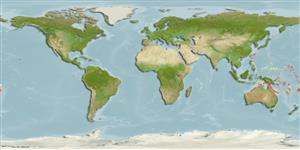Common names from other countries
>
Eupercaria/misc (Various families in series Eupercaria) >
Lethrinidae (Emperors or scavengers) > Monotaxinae
Etymology: Gymnocranius: Greek, gymnos = naked + Greek, kranion = skull (Ref. 45335); superciliosus: Named for the conspicuous dark patch above eye, which evokes an eyebrow..
Environment: milieu / climate zone / depth range / distribution range
Ekologi
laut; kisaran kedalaman 5 - 20 m (Ref. 107926). Tropical
Southwest Pacific: New Caledonia, Chesterfield Is., and Fiji
Size / Weight / umur
Maturity: Lm ? range ? - ? cm
Max length : 43.0 cm SL jantan/; (Ref. 107926)
deskripsi pendek
Morfologi | Morfometrik
This species is distinguished by the following: a slender species with ratio of standard length to body depth between 2.65-3.06; forehead bumpy and lower edge of eye well above axis of body; moderately forked caudal fin with lobes slightly rounded; scales rows above lateral line 6; pored
scales on lateral line 48-49; colour of flanks silvery; scales above lateral line with a dark-grey basal patch forming longitudinal rows; scales with similar dark-grey basal patch on a more or less
extended portion of flank below lateral line; up to 24 or more pale-blue speckles against bronze background on snout and cheeks, distinctive on fresh and larger individuals but faint on smaller individuals; a pale-blue band joining the nostrils on forehead and reaching the eyes, bright in freshly captured larger individuals; the area immediately above eye (supraorbital shelf) forming a distinctive blackish eyebrow; more or less conspicuous vertical dark bar crossing the eye; upper lip is reddish to red while lower lip is white; the dorsal, pectoral, anal and caudal fins reddish to red (Ref. 107926).
Occurs on coral-sand bottom and collected using handlines; in lagoons and large pools. Stomach contents include broken bivalve shells and scraps of urchin shell (Ref. 107926).
Life cycle and mating behavior
Kematangan | Reproduksi, perkembang biakan | Pemijahan | telur-telur | Fecundity | Larva
Borsa, P., P. Béarez, S. Paijo and W.-J. Chen, 2013. Gymnocranius superciliosus and Gymnocranius satoi, two new large-eye breams (Sparoidea: Lethrinidae) from the Coral Sea and adjacent regions. Comptes Rendus Biologies 336: 233-240. (Ref. 107926)
Status IUCN Red List (Ref. 130435)
CITES (Ref. 128078)
Not Evaluated
ancaman kepada manusia
Harmless
penggunaan manusia
informasi lanjut
Umur / SaizPertumbuhanpanjang-beratpanjang-panjangukuran frekuensiMorfometrikMorfologiLarvaDinamika larvapemulihanKelimpahan
AcuanBudidaya airprofil budidaya airStrainGenetikaElectrophoresesDiturunkanPenyakit-penyakitPengolahanMass conversion
mitraGambarStamps, Coins Misc.Suara-suaraCiguateraKecepatanTipe renangArea insangOtolithsOtakPenglihatan / visi
Alat, peralatan
laporan khas
muat turun XML
Sumber internet
Estimates based on models
Phylogenetic diversity index (Ref.
82804): PD
50 = 0.5010 [Uniqueness, from 0.5 = low to 2.0 = high].
Bayesian length-weight: a=0.01778 (0.00761 - 0.04154), b=2.97 (2.78 - 3.16), in cm Total Length, based on LWR estimates for this (Sub)family-body shape (Ref.
93245).
Trophic level (Ref.
69278): 3.4 ±0.6 se; based on size and trophs of closest relatives
Daya lenting (Ref.
120179): sedang, Waktu penggandaan populasi minimum 1.4 - 4.4 tahun (Preliminary K or Fecundity.).
Fishing Vulnerability (Ref.
59153): Moderate vulnerability (41 of 100).
